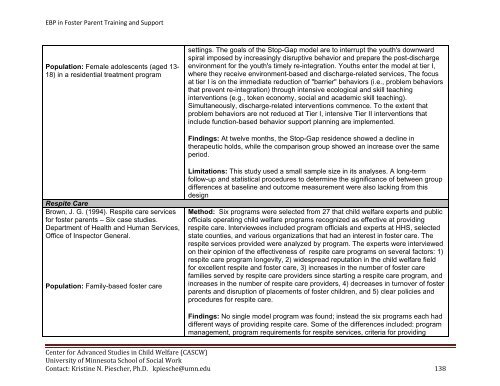Evidence-Based Practice in Foster Parent Training and Support ...
Evidence-Based Practice in Foster Parent Training and Support ...
Evidence-Based Practice in Foster Parent Training and Support ...
You also want an ePaper? Increase the reach of your titles
YUMPU automatically turns print PDFs into web optimized ePapers that Google loves.
EBP <strong>in</strong> <strong>Foster</strong> <strong>Parent</strong> Tra<strong>in</strong><strong>in</strong>g <strong>and</strong> <strong>Support</strong>Population: Female adolescents (aged 13-18) <strong>in</strong> a residential treatment programsett<strong>in</strong>gs. The goals of the Stop-Gap model are to <strong>in</strong>terrupt the youth's downwardspiral imposed by <strong>in</strong>creas<strong>in</strong>gly disruptive behavior <strong>and</strong> prepare the post-dischargeenvironment for the youth's timely re-<strong>in</strong>tegration. Youths enter the model at tier I,where they receive environment-based <strong>and</strong> discharge-related services, The focusat tier I is on the immediate reduction of "barrier" behaviors (i.e., problem behaviorsthat prevent re-<strong>in</strong>tegration) through <strong>in</strong>tensive ecological <strong>and</strong> skill teach<strong>in</strong>g<strong>in</strong>terventions (e.g., token economy, social <strong>and</strong> academic skill teach<strong>in</strong>g).Simultaneously, discharge-related <strong>in</strong>terventions commence. To the extent thatproblem behaviors are not reduced at Tier I, <strong>in</strong>tensive Tier II <strong>in</strong>terventions that<strong>in</strong>clude function-based behavior support plann<strong>in</strong>g are implemented.F<strong>in</strong>d<strong>in</strong>gs: At twelve months, the Stop-Gap residence showed a decl<strong>in</strong>e <strong>in</strong>therapeutic holds, while the comparison group showed an <strong>in</strong>crease over the sameperiod.Respite CareBrown, J. G. (1994). Respite care servicesfor foster parents – Six case studies.Department of Health <strong>and</strong> Human Services,Office of Inspector General.Population: Family-based foster careLimitations: This study used a small sample size <strong>in</strong> its analyses. A long-termfollow-up <strong>and</strong> statistical procedures to determ<strong>in</strong>e the significance of between groupdifferences at basel<strong>in</strong>e <strong>and</strong> outcome measurement were also lack<strong>in</strong>g from thisdesignMethod: Six programs were selected from 27 that child welfare experts <strong>and</strong> publicofficials operat<strong>in</strong>g child welfare programs recognized as effective at provid<strong>in</strong>grespite care. Interviewees <strong>in</strong>cluded program officials <strong>and</strong> experts at HHS, selectedstate counties, <strong>and</strong> various organizations that had an <strong>in</strong>terest <strong>in</strong> foster care. Therespite services provided were analyzed by program. The experts were <strong>in</strong>terviewedon their op<strong>in</strong>ion of the effectiveness of respite care programs on several factors: 1)respite care program longevity, 2) widespread reputation <strong>in</strong> the child welfare fieldfor excellent respite <strong>and</strong> foster care, 3) <strong>in</strong>creases <strong>in</strong> the number of foster carefamilies served by respite care providers s<strong>in</strong>ce start<strong>in</strong>g a respite care program, <strong>and</strong><strong>in</strong>creases <strong>in</strong> the number of respite care providers, 4) decreases <strong>in</strong> turnover of fosterparents <strong>and</strong> disruption of placements of foster children, <strong>and</strong> 5) clear policies <strong>and</strong>procedures for respite care.F<strong>in</strong>d<strong>in</strong>gs: No s<strong>in</strong>gle model program was found; <strong>in</strong>stead the six programs each haddifferent ways of provid<strong>in</strong>g respite care. Some of the differences <strong>in</strong>cluded: programmanagement, program requirements for respite services, criteria for provid<strong>in</strong>gCenter for Advanced Studies <strong>in</strong> Child Welfare (CASCW)University of M<strong>in</strong>nesota School of Social WorkContact: Krist<strong>in</strong>e N. Piescher, Ph.D. kpiesche@umn.edu 138
















